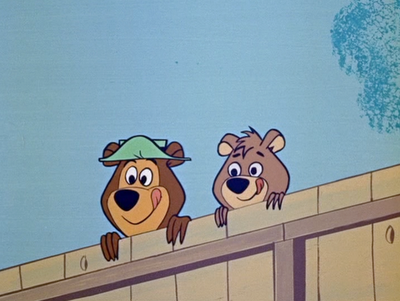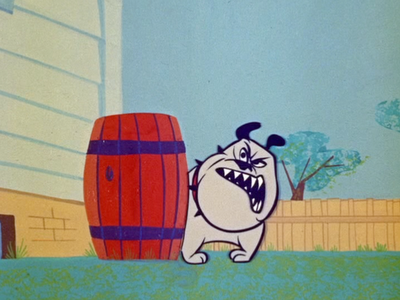
Boo Boo had a different voice in the first cartoon. It was nasally.
Watch Boo Boo with a cold....
During the summer break between season 1 and 2 of Ren and Stimpy, I asked the Nickelodeon folks to let me keep my key artists on so I could have some training classes to improve all our skills, so that we could up the quality for the second season. To my amazement, they agreed!
One of the classes I had was on Story Structure. I firmly believed that cartoonists should write cartoons and had convinced Nickelodeon of it. Not every cartoonist can write of course, but only cartoonists should write cartoons - just as only dancers can "write" (choreograph) dances, musicians can write music and sculptors can "write" sculptures.
I had a few cartoonists who were really funny, and those were the ones that had written the first season of Ren and Stimpy, because they could come up with a lot of gags. I found, though that I ended up having to structure all the stories, making them make sense, making them build, making the characters seem motivated and writing the dialogue so it seemed like each character spoke in his own style.
Some of the funniest cartoonists at the first Spumco were Bob Camp, Jim Smith, Jim Gomez, Vincent Waller and Rich Pursel. That was my main writing team, but almost every other artist contributed gags and ideas all through the production (almost all cartoonists are funny and I never turn down a good gag if it's in character), and now and then I would let an artist from another department do storyboards. BG painter Bill Wray did the board for Powdered Toastman and added lots of gags that weren't in the outline; "Cling tenaciously to my buttocks!" made me fall on the floor laughing. Chris Reccardi killed me with "You're next! Meeester Doggie Treeeeat!" in Man's Best Friend.
So even though you might have raw story and gag talent, you still need to know the skills of writing. Some are general, and some are specific to cartoons. Sometimes my writers would have Stimpy do things that were more suited to Ren, or the dialogue would seem just expositional, or the gags would not build, they would put the best gag first and follow with weaker gags of the same kind, etc...so I wanted to develop everyone's technical writing skills.
During the first class I held on story structure, I picked a cartoon to screen that was very simple and direct. It was the first Yogi Bear cartoon: Pie Pirates. I made everyone watch it and then write a story outline of what the point of the story was, what the characters' motivations were, what their personalities were and then to list each story point and gag in order.
IMPORTANT POINT: I didn't choose this cartoon because it was the funniest cartoon in the world or had the greatest animation. I chose it specifically because it was so simple that it was easy to analyze. The story is clear and doesn't have random twists and turns. All the gags are true to the premise of the cartoon and they build. Period.
I believe when you are learning anything, you should start with learning the simplest fundamental steps. If you want to dance, you don't start by studying Fred Astaire. You study Bill Robinson with a teacher who can break down his steps for you.
That's why I recommend Preston Blair to everyone who wants to draw cartoons. It has the same fundamentals that Bambi or Sleeping Beauty has, but they are easier to see in simple characters. You can't learn to animate by starting on a walk cycle using Aurora's design! (I know this from direct experience!)
 "Pie Pirates" (1958)
"Pie Pirates" (1958)The story was about a big conniving, lazy but lovable bear and his nervous goody goody sidekick who are hungry.
They smell a freshly baked pie,look over a fence and see it cooling on a window ledge. Yogi wants to steal it, Boo Boo thinks it's a bad idea, but goes along with it.
The only problem is, there is a big mean guard dog in the yard and Yogi will have to get past the dog to get the pie, and most of the gags are about Yogi trying to outwit the dog to get to the pie. A typical situational short cartoon premise with an easy motivation that you can build gags on.
They smell a freshly baked pie,look over a fence and see it cooling on a window ledge. Yogi wants to steal it, Boo Boo thinks it's a bad idea, but goes along with it.
The only problem is, there is a big mean guard dog in the yard and Yogi will have to get past the dog to get the pie, and most of the gags are about Yogi trying to outwit the dog to get to the pie. A typical situational short cartoon premise with an easy motivation that you can build gags on.
 "A Yard Too Far" (1993)
"A Yard Too Far" (1993)After everyone wrote up their outlines, I think I then asked them to come up with a simple structure of their own. I actually don't remember. I do remember this whole exercise studying a Yogi Bear cartoon tortured Eddie!
At a story session later, we were talking about Pie Pirates and I said, "Let's take the plot of Pie Pirates and just replace all the elements but leave the same structure!"
We replaced Yogi and Boo Boo with Ren and Stimpy.

At a story session later, we were talking about Pie Pirates and I said, "Let's take the plot of Pie Pirates and just replace all the elements but leave the same structure!"

We replaced Yogi and Boo Boo with Ren and Stimpy.


 We replaced the pie with a plate of steaming hog jowls.
We replaced the pie with a plate of steaming hog jowls.
 The bulldog was replaced by a baboon in the yard.
The bulldog was replaced by a baboon in the yard.
Bob Camp did hilarious drawings of the baboon!


 Bob Camp did the storyboard and this was a cartoon at Spumco, but it got produced at "Games" the first version of the Nickelodeon studio.
Bob Camp did the storyboard and this was a cartoon at Spumco, but it got produced at "Games" the first version of the Nickelodeon studio.Here are more images from Pie Pirates.
 I think we left this guy out.
I think we left this guy out. It's a very limited animation cartoon-not even any inbetweens! But it's animated by Mike Lah and looks very Tex Avery-ish. Mike was an animator for Tex at MGM and when Tex left, he became the director for his unit. I don't mind limited animation if it has good posing, and I have a special affection for this cartoon. I love the rings around Yogi's eyes too!
It's a very limited animation cartoon-not even any inbetweens! But it's animated by Mike Lah and looks very Tex Avery-ish. Mike was an animator for Tex at MGM and when Tex left, he became the director for his unit. I don't mind limited animation if it has good posing, and I have a special affection for this cartoon. I love the rings around Yogi's eyes too!








And more images from A Yard Too Far.


















